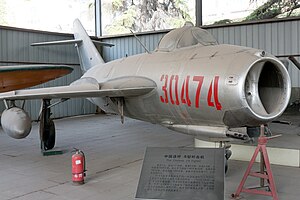Daesŭngri DS-1
| Daesŭngri DS-1 | |
|---|---|

| |
| DS-1G in the Dongchŏn Military Museum | |
| Role | Fighter aircraft |
| National origin | DPRM |
| Manufacturer | Daesŭngri Aviation Bureau |
| Introduction | 1965 |
| Primary users | Menghean People's Army (historical) Dzhungestani Air Force (historical) |
| Produced | 1965-1970 |
| Number built | 451 |
| Developed from | Mikoyan-Gurevich MiG-17 |
The Daesŭngri DS-1 (Formal designation: 대승리 1호 전투기 / 大勝利一號戰鬪機, Daesŭngri Il-ho Jŏntugi, "Daesŭngri No.1 Fighter;" Short designation 대승리-1 Daesŭngri-il "Daesŭngri-1") is a Menghean-built version of the Letnian Mikoyan-Gurevich MiG-17 single-seat jet fighter. For a few years after its introduction it was also designated Type 65, with the designation DS-1 first appearing around 1970. Already obsolete at the time of its introduction, it is no longer in active service with the Menghean armed forces.
History
Menghean pilots gained extensive experience flying the MiG-17 during the late stages of the Menghean War of Liberation, using airframes which were sold to Polvokia and later smuggled across the northern border. Despite its lack of missiles and supersonic capability, the MiG-17 made a favorable impression on Menghean pilots.
As the war neared its end, Menghe secured a license from Letnia to produce the MiG-17 domestically. Plans were delivered in 1964, and factory equipment was delivered in the same year, accompanied by knockdown kits for asembling the first 34 airframes. The Daesŭngri Aircraft Production Bureau set up an assembly center in a factory complex in Girim province, which the Menghean Liberation Army had already been using as a MiG-17 repair site since 1962, and production began in the summer of 1965.
Design
The baseline Type 65G (DS-1G) is essentially identical to the MiG-17AS, the multirole variant of the MiG-17 with limited ground-attack capability. It has two under-wing hardpoints, which can be used to carry 250-kg unguided bombs or UB-16-57 rocket pods. It lacks any kind of radar, even a ranging set, and also lacks the ability to carry heat-seeking air-to-air missiles. In air-to-air combat, it is entirely reliant on its gun armament.
A two-seat trainer variant was also produced. Somewhat confusingly, it was originally designated Type 65N, but later changed to DS-1G2. Originally it was intended as a lead-in trainer for the DS-1G, with two DS-1G2s per 18-plane squadron. After the DS-1G was deemed obsolete and the DS-2 emerged as its replacement, production of the DS-1 switched over to the DS-1G2 variant, which accounted for all production in 1969 and 1970. These airframes were used as trainers for the DS-2, which lacked a lead-in trainer variant until the introduction of the DS-2N2 in 1970.
By the late 1970s, the DS-1 was widely regarded as obsolete, and the Menghean People's Air Force began to retire it from front-line service. Many DS-1G airframes were converted to radio-controlled drones, designated DS-1PJG (Pyojŏkgi, "target plane") and used for air-to-air and surface-to-air missile testing. Large numbers of DS-1G2s remained in use as intermediate trainers between propeller planes and service jets like the DS-5 and SR-6, but there are some reports of DS-1G2s being converted to target drones, in which case they bore the same DS-1PJG designation.
Variants
- DS-1G: Single-seater fighter variant, originally known as Type 65G. 213 produced.
- DS-1G2: Twin-seater lead-in trainer, originally known as Type 65N. 225 produced, most after 1967.
- DS-1RD: Possible designation for a prototype with a ranging radar in the middle of the nose splitter, likely a copy of the "Izmrud" radar from the MiG-17P. 1 built.
- DS-1JPG: Prototype fighter-bomber with modified hardpoints for heavier bombs. 2 built. Rejected in favor of the DS-2.
- DS-1PJG: Unmanned target drone made from converted DS-1 airframes.
Operators
 Dzhungestan: 56 units sold to Communist forces in 1974
Dzhungestan: 56 units sold to Communist forces in 1974 Democratic People's Republic of Menghe
Democratic People's Republic of Menghe
Specifications (DS-1G)
General characteristics
- Crew: 1
- Length: 11.26 m (37 ft)
- Wingspan: 9.63 m (31 ft 7 in)
- Height: 3.8 m (12 ft 6 in)
- Wing area: 22.6 m2 (243.3 ft2)
- Empty weight: 3,870 kg (8,532 lb)
- Loaded weight: 5,290 kg (11,660 lb)
- Max. takeoff weight: 6,050 kg (13,340 lb)
- Powerplant: 1 × Klimov VK-1F afterurning turbojet
- Dry thrust: 26.5 kN (5,955 lbf)
- Thrust with afterburner: 33.8 kN (7,423 lbf)
Performance
- Maximum speed: 1,150 km/h (Mach 0.93)
- Ferry range: 2,020 km (1,255 mi) at 12,000 m with 2x 400L drop tanks
- Service ceiling: 16,600 m (54,450 ft) with afterburner
- Rate of climb: 65 m/s (12,800 ft/min)
- Wing loading: 268.4 kg/m2 (55 lb/ft2)
- Thrust/weight: 0.63
Armament
- Guns:
- 2 × 23mm autocannon (80 rounds per gun)
- 1 × 37mm autocannon (40 rounds total)
- Hardpoints: 2 hardpoints with a capacity of 500 kg and provisions to carry combinations of:
- Rockets: 2 × UB-16-57 rocket pods for S-5 rockets
- Bombs: 2 × 250 kg (550 lb) bombs
- Other: 2 × 400L drop tank

